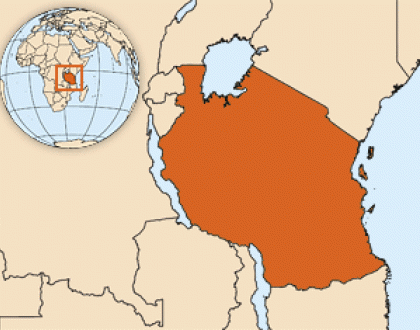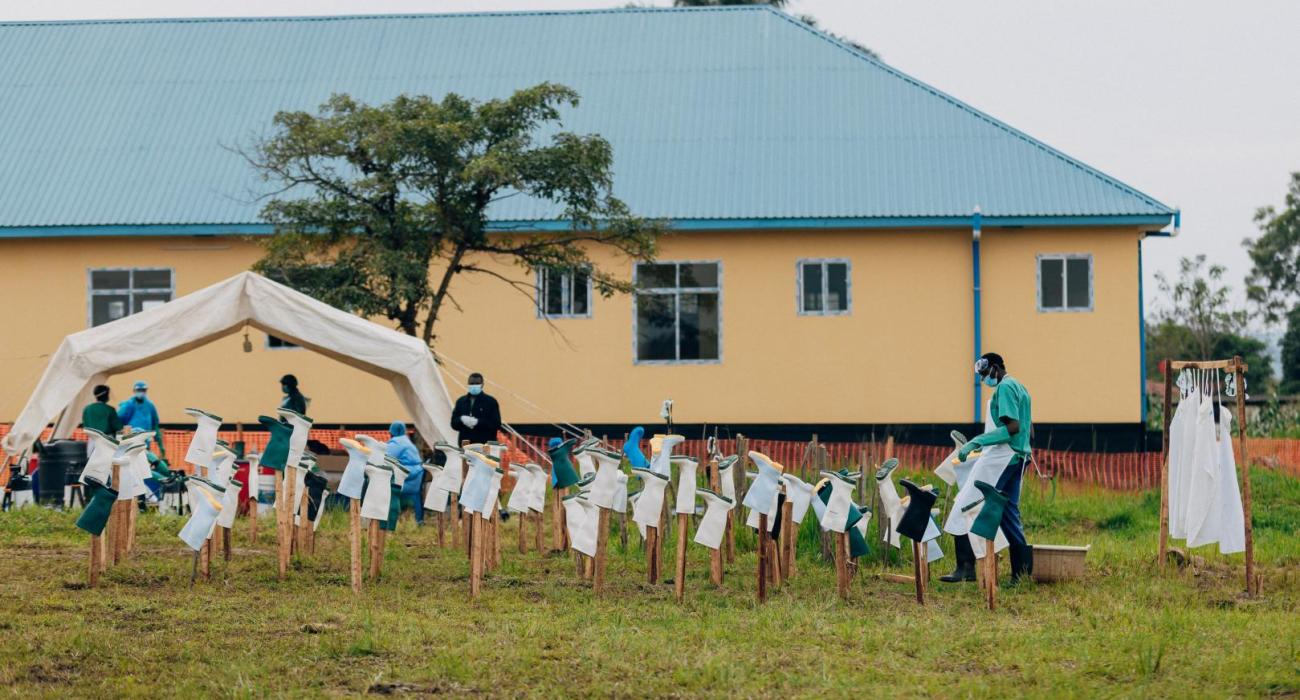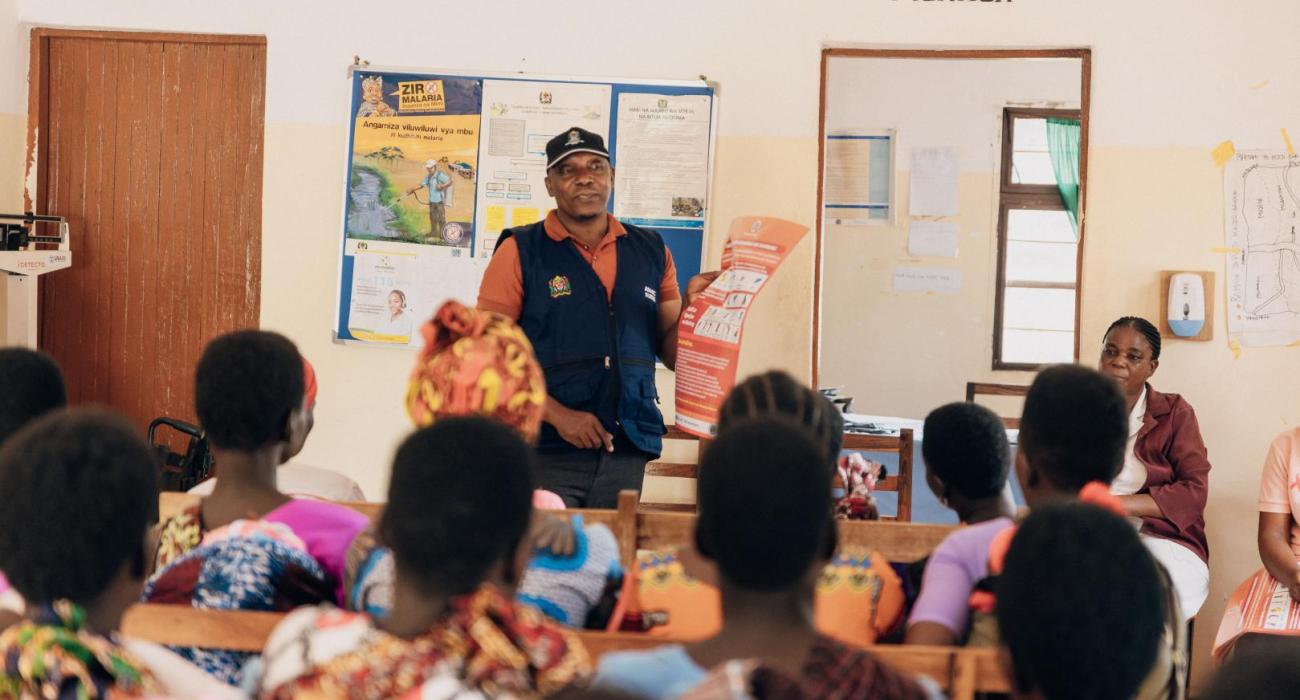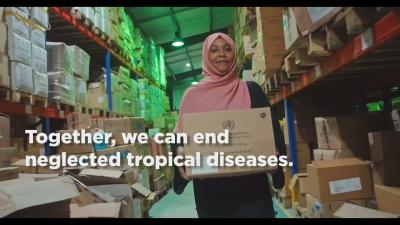| Total population (2015) | 53,470,000 |
| Gross national income per capita (PPP international $, 2013) | 1 |
| Life expectancy at birth m/f (years, 2015) | 60/64 |
| Probability of dying under five (per 1 000 live births, 0) | n/a |
| Probability of dying between 15 abd 60 years m/f (per 1 000 population, 2013) | 311/245 |
| Total expenditure on health per capita (Intl $, 2014) | 137 |
| Total expenditure on health as % of GDP (2014) | 5.6 |
United Republic of Tanzania
Renseignements de Pays
Données & statistiques

Country Health Topics
The United Republic of Tanzania country health profiles provide an overview of the situation and trends of priority health problems and the health systems profile, including a description of institutional frameworks, trends in the national response, key issues and challenges. They promote evidence-based health policymaking through a comprehensive and rigorous analysis of the dynamics of the health situation and health system in the country.
The way the health system is financed and organized is a key determinant of population health and well-being. Health financing has become a central issue in Tanzania as the government seeks to improve its health system, with policy debates covering the questions of how funds should be raised, how they should be pooled to spread risks, and how they should be used to provide the services and programmes needed by their populations.
The level of spending is still insufficient to ensure equitable access to basic and essential health services and interventions, so the major concern is to ensure adequate mobilization and equitable resource allocation for health.
External sources have recently provided substantial increases in resources for selected health interventions, leading to increased attention focuses on how to sustain such increased expenditure over time. Health costs have been rising rapidly and a dominant concern is to make tough priorities in health spending at the same time reduce the rate of growth of health expenditure while maintaining the quality of the health system.
The current health financing options are not effectively offering social protection. The government is concerned in ensuring that the resources available to health are used efficiently and that they are distributed equitably, yet disparities in access to services between rural and urban areas and between the sex's remains in many settings.
Health financing heavily relies on out-of-pocket payments, placing large, sometimes catastrophic, financial burdens on households who can be pushed into poverty, or further into poverty, as a result. Moreover, the need to make such payments prevents people, especially those who are poor, from obtaining necessary care.
The immunization programme in Tanzania has as its goal reduction in morbidity and mortality due to vaccine preventable diseases. The programme’s broad areas of activity are in routine immunization service delivery, disease surveillance and coordination of supplementary immunization activities.
In the recent past, Tanzania has been in a process of revitalization, with improvements in the planning process, community ownership and involvement, improving coverage, effective mobilization of funds for EPI, improvements in safety of vaccine delivery and introduction of new and under utilized vaccines. Auto Destruct syringes are now used in the programme, and the vaccine for Hepatitis B was introduced, to be delivered as a combination vaccine with DTP, in the immunization schedule since 2002.
To continue implementing its mandate IVD has assisted the EPI programme has identify strategies to undertake and fill funding gap through:
- mobilizing additional resources;
- improving the reliability of resources though ICC and Partiners; and
- improving the efficiency of the programme.
This programme supports the building up of blood transfusion services in Zanzibar, covering all components of the service, and ensuring sustainability.
The programmes for which WHO will provide support are selected every two years through consultations with the Ministry of Health. They are then incorporated into a country's biannual programme budget. WHO could provide some additional support ranging from capacity building/strengthening, to policy development in a field of health.
Activities in this area of work are being implemented within the context of the Global Primary Prevention of Substance Abuse. The main focus is on the Mental Health Policy Guidelines and support to several NGOs in the implementation of programmes on primary prevention of substance abuse.
The vision for this area of work is to support the government of Tanzania to ensure that all people have access to the essential medicines they need and can afford; that the medicines are safe, effective, and of good quality; and that the medicines are prescribed, dispensed and used rationally. It also supports the country in integrating traditional medicine into the health delivery system and for ensuring the safe practice of traditional medicine.
It aims at strengthening the pharmaceutical sector in Tanzania within the WHO`s Medicine Strategy and the Africa Region’s Intensified Essential Drugs Programme which support areas of medicine policies development, monitoring and evaluation; access; quality and safety and promotion of rational use of essential medicines. Similarly it aims at guiding the development of traditional medicine (TM) and complementary or alternative medicine in the country within the WHO Regional Traditional Medicine Strategy which has the following objectives:
- to develop a framework for integration of the positive aspects of TM into health systems and services;
- to establish mechanisms for the protection of cultural and intellectual property rights;
- to develop viable local industries to improve access to TM;
- to strengthen national capacity to mobilize stakeholders and formulate and implement relevant policies; and
- to promote the cultivation and maintenance of medicinal plants.
Health promotion is primarily a process used to address various sources of ill health especially those related to life style. In Tanzania, the focus has been in the development of the National Health Promotion Policy Guidelines and provision of technical support in health promotion, procurement and dissemination of appropriate health information, community involvement and participation, and ensuring greater involvement of other sectors in health related actions.
It also covers the promotion of policy guidelines on environmental health including promotion of the Healthy Settings Approach, food safety, chemical management and safety, occupational hygiene and safety as well as emergency preparedness and response (EPR). An achievement in this area includes having health promotion focal persons at district level in all the districts in the country to coordinate and facilitate health promotion activities at community level.
The Ministry of Health and Social Welfare in collaboration with WHO has trained first responders from different areas and has formed EPR teams in two regions prone to motor accidents.
The inclusion of Making Pregnancy Safer as part of Safe Motherhood was adopted by the 49th Session of the WHO Regional Committee for Africa.
The maternal mortality ratio (MMR) is estimated to be 578 per 100 000 live births with about 80% of deaths occurring during childbirth and in the immediate postpartum period. The neonatal mortality rate is 32 per 1 000 live births and the infant mortality rate is estimated at 68 per 1 000 live births (Source: Tanzania Demographic and Health Survey 2004 - 2005).
Tanzania has developed a National Road Map Strategic Plan to accelerate reduction of maternal and newborn deaths. The Road Map provides guidance for national efforts in addressing maternal and newborn health and recognizes the existence of other strategies and initiatives with respect to reproductive and child health care. Regular monitoring of the Road Map will ensure that it is implemented towards attainment of the Millennium Development Goals (MDGs)
In Tanzania, WHO has been working in collaboration with other partners in providing a leadership role in developing standards for care and treatment of women and girls that incorporate gender equalities and equity in health delivery, and advising on functions that health facilities should perform in order to reduce risks associated with pregnancy and child birth.
Adolescents (aged 10-24 years) have very special needs and continue to face limited access to information and quality and friendly services to enable them to reach their full potential. Adolescents are also at a higher risk of acquiring sexually transmitted diseases including HIV/AIDS.
WHO assists in Tanzania to develop strategies to address the special needs for this age group in terms of knowledge and services. WHO advocates for the involvement of adolescents and parents provision of adolescent-friendly services.
This is a strategy developed by WHO and UNICEF in 1995 with the goal of contributing to the reduction of infant and childhood morbidity and mortality due to common killers of children under five years. These include malaria, diarrhoea, pneumonia, measles, malnutrition and anaemia. These are addressed in an integrated manner.
The approach aims at improving health worker's skills to manage childhood illnesses, improving health system support as well as family and community practices. WHO is providing support to the Ministry of Health and other stakeholders to introduce and scale up the approach including monitoring and evaluation of the strategy.
The WCO has been keeping this area active despite handicaps of financing. Main activities have been the collaborative venture with Tanzania Training Center for Orthopedic Technicians (TATCOT) at KCMC Kilimanjaro under USAID support which came to an end in 2006.
Gains from this collaboration have been innovations in Wheelchair Technology, motivating organization of Spinal Injured persons for self-care and affirmative action, and facilitation of TATCOT to become a WHO Collaborating Centre.
The WCO has been keeping this area active despite handicaps of financing. Main activities have been the collaborative venture with Tanzania Training Center for Orthopedic Technicians (TATCOT) at KCMC Kilimanjaro under USAID support which came to an end in 2006.
Gains from this collaboration have been innovations in Wheelchair Technology, motivating organization of Spinal Injured persons for self-care and affirmative action, and facilitation of TATCOT to become a WHO Collaborating Centre.
Disease reporting in Tanzania has improved steadily and the ministry of health is now reporting weekly by its 114 districts and continues to report monthly as well. Disease surveillance, reporting and responding to outbreaks is also solid.
WHO and the Ministry of Health work in a coordinated and efficient manner. WHO has also responded to MOH requests for support during outbreaks, e.g. in supply of drugs or in outbreak investigations. Other teams work in close collaboration in sharing, data, transport, assignments such as in the training where appropriate. Management of data and its use has also been given special priority.
Malaria (MAL)
Tanzania is one of the countries at the forefront of implementing the Roll Back Malaria (RBM) partnership.
WHO assists the country directly in implementing and scaling up the malaria control interventions in the areas of case management, vector control, malaria in pregnancy, malaria epidemics, and monitoring and evaluation. WHO supports the country to prepare a strategic plan, as well as relevant guidelines for different interventions.
Other support given to specific areas include: monitoring the antimalarial drugs efficacy and guiding the country in change of treatment policy for effective case management, scaling up insecticide treated net (ITN) use through cost effective approaches such as the voucher scheme for the vulnerable groups, and intermittent presumptive treatment (IPT) in pregnant women. Support in putting in place an effective monitoring system for indoor residual spraying (IRS), which is a relatively new intervention for Tanzania.
HIV/AIDS
The national response to the HIV/AIDS epidemic was guided by the Ministry of Health since the advent of the epidemic in 1983 to 2001.
The HIV prevalence previously recorded as 9.9% is currently reported at 7% (Source: HIV/AIDS- Indicator Survey 2003-2004, March 2005). The cross-cutting effects of the pandemic have produced a rapidly growing orphan population. Responses to mitigate the attendant economic and social effects are piecemeal and insufficient.
With the establishment of the Tanzania Commission for AIDS (TACAIDS) which is now charged with the responsibility of guiding the national multisectoral response to the epidemic, the challenge for WHO is to assist and facilitate in the definition, elaboration and implementation of a health sector HIV/AIDS response.
WHO provides the required technical assistance for developing and implementing essential packages of effective health sector HIV/AIDS interventions for the various levels of the health service delivery. WHO is an active member of HIV/AIDS Theme Group (UN), and the broader coordination mechanism that includes donors.
Tuberculosis (TB)
WHO participates in the control of tuberculosis in the country as part of a broad partnership by providing technical support. The programme faces an increase in TB case notifications mostly due to the impact of the HIV epidemic in the country.
The Tanzania TB programme is one of the best in the world, supported by several collaborating partners and is implementing the DOTS Strategy countrywide.
Communicable diseases control and prevention (CPC)
Communicable diseases continue to be a major health problem in Tanzania with very high prevalence among all the population; for schistosomiasis and helminthiasis a great majority is in children.
WHO has therefore assisted the Ministry of Health in selecting priority diseases for control and is providing technical and adequate resources in their control. The following diseases were jointly identified as priority:
- leprosy
- onchocerciasis
- lymphatic filariasis
- schistosomiasis and helminthiasis, and
- human African trypanosomiasis, trachoma.
WHO supports the health reform processes in the country. This area of work includes developing human resource for health (planning, fellowships, advocacy for equity of deployment and retention), supporting health systems development, especially at district level, strengthening of managerial processes in the health sector, and building partnerships.
Promoting and strengthening evidence based-medicine and health interventions including facilitating linkage to and processing designation of WHO Collaborating Centres enables the country office to access knowledge and information for sharing.
Health system: evolution, key functions, main actors, goals, and principle challenges
The principle challenges facing the health system are the HIV/AIDs catastrophe, human resources insufficiency and de-motivation and insufficient funds to meet the growing burden of disease. In Zanzibar resource constraints in health (human and financial) are significant.
The Ministries of Health and Social Welfare (Mainland Tanzania and Zanzibar) have shifted emphasis from supporting curative care inclined institutions to public and community health by promoting organizations collaborating with Local Government, extended network of Public Services, NGO’s services and more recently private service providers. The Ministries are in the process of transformation from centralized pyramidal structures to decentralized, devolved managed care systems with central functions of policy guidance, regulation, oversight and support, and supervision including monitoring and evaluation.
The national Health policy of 1990 was revised in 2002, subsequently the Mainland Health Strategic plan was developed in 2003.Goals outlined in the policy include:
- Access to quality primary health care for all
- Access to quality reproductive health service for all individuals of appropriate ages
- Reduction in infant and maternal mortality rates by three quarters from current levels
- Universal access to safe water
- Life expectancy comparable to the level attained by typical middle-income countries
- Food self-sufficiency and food security
- Gender equality and empowerment of women in all health parameters.
Districts and Health Facilities are responsible for planning and management of district health care and health services respectively.
Main actors include Central Ministry of Health, President’s Office Regional Administration and Local Government, NGOs and Faith Based Organizations, Development Partners in Health both Bilateral and Multilateral.





